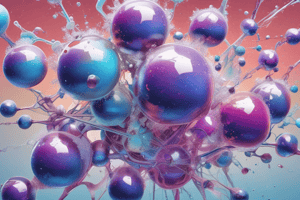Podcast
Questions and Answers
What is formed when mercury (II) oxide is broken down by heat?
What is formed when mercury (II) oxide is broken down by heat?
- Chocolate and nuts
- Carbon and water
- Vinegar and oil
- Mercury and oxygen (correct)
Which term describes a mixture with a composition that varies from point to point?
Which term describes a mixture with a composition that varies from point to point?
- Homogeneous mixture
- Elemental mixture
- Heterogeneous mixture (correct)
- Chemical compound
What is another name for a homogeneous mixture?
What is another name for a homogeneous mixture?
- Chemical mixture
- Elemental compound
- Heterogeneous solution
- Uniform mixture (correct)
Which separation technique is suitable for separating a heterogeneous mixture into its components?
Which separation technique is suitable for separating a heterogeneous mixture into its components?
What physical change occurs when Italian dressing settles into separate layers?
What physical change occurs when Italian dressing settles into separate layers?
Which type of mixture appears visually consistent throughout and has a uniform composition?
Which type of mixture appears visually consistent throughout and has a uniform composition?
Which type of mixture is a sports drink, according to the text?
Which type of mixture is a sports drink, according to the text?
Why is oil and vinegar salad dressing classified as a heterogeneous mixture?
Why is oil and vinegar salad dressing classified as a heterogeneous mixture?
What distinguishes compounds from mixtures, as mentioned in the text?
What distinguishes compounds from mixtures, as mentioned in the text?
How do we classify matter based on its composition?
How do we classify matter based on its composition?
What makes a physical change different from a chemical change?
What makes a physical change different from a chemical change?
Which type of mixture is air, according to the text?
Which type of mixture is air, according to the text?
Which category of matter has a constant composition and all specimens have exactly the same makeup and properties?
Which category of matter has a constant composition and all specimens have exactly the same makeup and properties?
What is the term for pure substances that cannot be broken down into simpler substances by chemical changes?
What is the term for pure substances that cannot be broken down into simpler substances by chemical changes?
Which technique is used to separate the components of a heterogeneous mixture based on the different boiling points of the substances?
Which technique is used to separate the components of a heterogeneous mixture based on the different boiling points of the substances?
What type of mixture is air, where oxygen, nitrogen, and other gases are uniformly distributed?
What type of mixture is air, where oxygen, nitrogen, and other gases are uniformly distributed?
Which term refers to pure substances that can be broken down into simpler substances by chemical changes?
Which term refers to pure substances that can be broken down into simpler substances by chemical changes?
What classification of matter includes mixtures and pure substances?
What classification of matter includes mixtures and pure substances?
How are elements classified in the periodic table?
How are elements classified in the periodic table?
What physical properties distinguish metals from nonmetals?
What physical properties distinguish metals from nonmetals?
In the periodic table, what do elements in the same group have in common?
In the periodic table, what do elements in the same group have in common?
What makes metalloids unique in terms of their properties?
What makes metalloids unique in terms of their properties?
How many periods does the periodic table have?
How many periods does the periodic table have?
What is the primary factor used to arrange elements in the periodic table?
What is the primary factor used to arrange elements in the periodic table?
Flashcards are hidden until you start studying
Study Notes
Classification of Matter
- Matter can be classified into two broad categories: mixtures and pure substances
- A pure substance has a constant composition, with all specimens having the same makeup and properties
- Pure substances can be further divided into two classes: elements and compounds
Elements
- Elements are pure substances that cannot be broken down into simpler substances by chemical changes
- There are over 100 known elements, with about 90 occurring naturally on earth and two dozen created in laboratories
- Examples of elements include iron, silver, gold, aluminum, sulfur, oxygen, and copper
Compounds
- Compounds are pure substances that can be broken down by chemical changes into elements or other compounds
- Examples of compounds include mercury (II) oxide, which can be broken down into mercury and oxygen when heated
Mixtures
- Mixtures are composed of two or more types of matter that can be present in varying amounts and can be separated by physical changes
- Mixtures can be classified into two categories: heterogeneous and homogeneous
Heterogeneous Mixtures
- Heterogeneous mixtures have a composition that varies from point to point
- Examples of heterogeneous mixtures include Italian dressing, chocolate chip cookies, and granite
- In these mixtures, the components can be separated and may settle out, resulting in different compositions at different points
Homogeneous Mixtures (Solutions)
- Homogeneous mixtures, also called solutions, have a uniform composition throughout
- Examples of homogeneous mixtures include sports drinks, air, maple syrup, gasoline, and a solution of salt in water
- Each part of a homogeneous mixture has the same composition and properties
Periodic Table of Elements
- The periodic table is a list of all known elements, organized by atomic number and chemical properties
- Dmitri Mendeleev was the first to classify elements in the periodic table
- The periodic table is arranged in a way that elements with similar chemical properties are grouped together
- The table is arranged in horizontal rows (periods) and vertical columns (groups)
Properties of Elements
- Metals are good conductors of heat and electricity, are malleable, ductile, and lustrous
- Nonmetals are poor conductors, brittle, and may not be malleable or ductile
- Metalloids exhibit some properties of metals and some properties of nonmetals
Studying That Suits You
Use AI to generate personalized quizzes and flashcards to suit your learning preferences.




